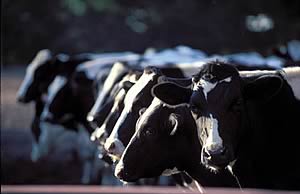 |
|||||||||
|
|||||||||||||||||||
|
|
Protect
High Value Heifers from Leptospirosis Now is the time to make sure high value dairy heifers are fully protected against bovine leptospirosis, well in advance of the peak disease transmission period at turnout.
“Turnout often heralds the mixing of cattle for the first time and the disease spreads easily between infected and uninfected animals at this time of year,” said Paul Williams MRCVS, livestock veterinary adviser, Schering-Plough UK. “Heifer replacements can be particularly vulnerable if they have not had their full primary vaccination course, which is two doses of Leptavoid-H four to six weeks apart. Ideally, the vaccine course should be completed by the end of the winter and at least two weeks before turnout,” he said. Two strains of leptospirosis affect UK cattle and at grass uninfected stock are suddenly exposed to the urine of infected animals that may be shedding leptospires. Cows become infected through urine splashing into their eyes, mouth or a cut in their skin and from the bull by infected semen. Moist grass is also a relatively favourable environment for leptospires and these organisms generally survive for longer outside the host in mild spring conditions. That’s why the spring is such a peak time for disease transmission. “Advance planning to make sure heifers are properly protected
from leptospirosis is crucial and only Leptavoid-H protects them
against both UK strains,” Williams said. “In addition
to any bought in stock, it is important that youngstock coming
onto the system are fully protected from the disease. Too often
heifers only get their first dose at the same time as the annual
herd boosters, but this is often too late from a practical point
of view. These young animals then get turned out to grass at the
same time as the lactating cows, but the youngsters often go to
quite remote parts of the farm so it’s easy to forget to
give them their second vaccination. It’s important for the
efficacy of the vaccine and the health of the animals that this
doesn’t happen.”
|
||||||||||||||||||

|
|
||||||||||||||||||
| home | agri-services | pedigree
pen | news | dairy | beef | machinery property | organisations | site map |
|||||||||||||||||||

